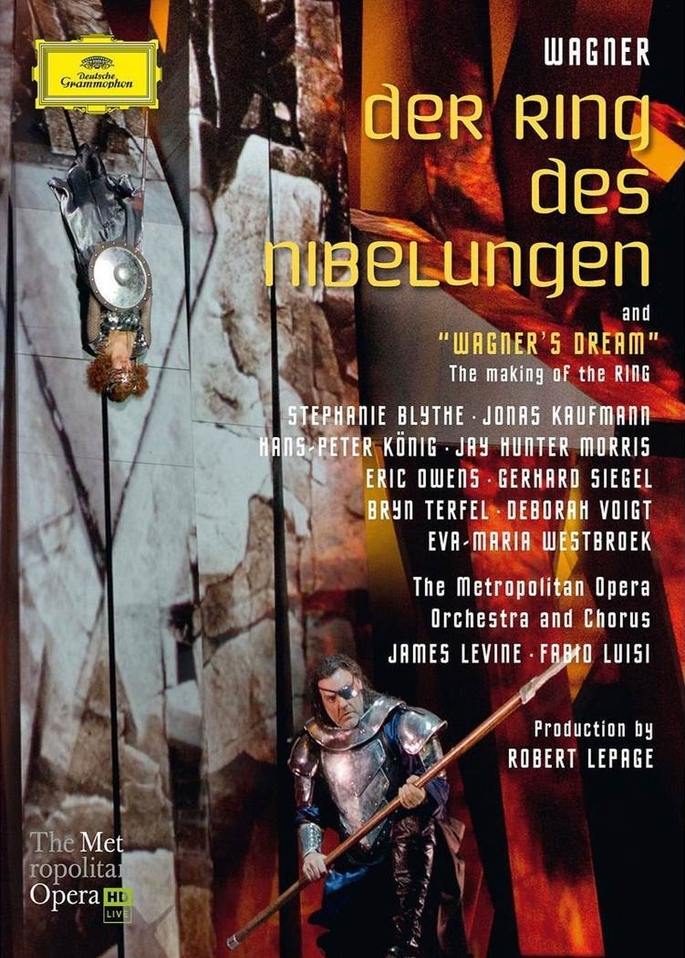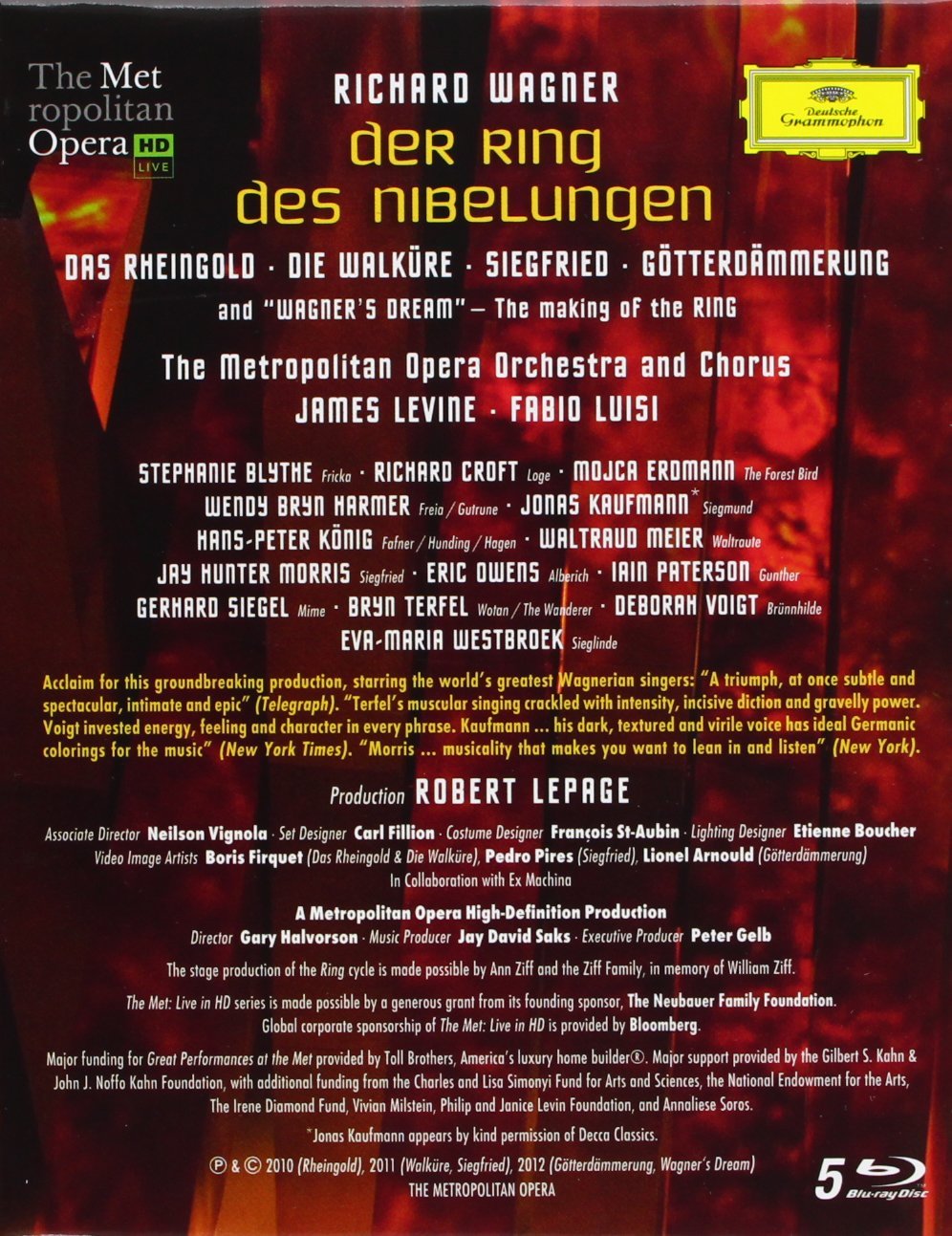

Wagner Der Ring des Nibelungen opera cycle directed by Robert Lepage from 2010 through 2012 at the Metropolitan Opera. This is a box set of 5 Blu-ray discs, containing the entirety of the Ring cycle. As of 2013, the 4 operas and the stand-alone documentary extra are available individually as well. Directed for TV by Gary Halvorson; music produced by Jay David Saks. Sung in German. Released 2012, the opera discs have 5.1 dts-HD Master Audio sound.
Das Rheingold. Produced 2010. Stars Bryn Terfel, Dwayne Croft, Adam Diegel, Richard Croft, Eric Owens, Gerhard Siegel, Franz-Josef Selig, Hans-Peter König, Stephanie Blythe, Wendy Bryn Harmer, Patricia Bardon, Lisette Oropesa, Jennifer Johnson, and Tamara Mumford. James Levine conducts the Metropolitan Opera Orchestra. Associate Direction by Neilson Vignola; set design by Carl Fillion; costume design by François St.-Aubin; lighting design by Etienne Boucher; video image art by Boris Firquet in collaboration with Ex Machina.
Die Walküre. Produced 2011. Stars Jonas Kaufmann, Hans-Peter König, Bryn Terfel, Eva-Maria Westbroek, Deborah Voigt, Stephanie Blythe, Kelly Cae Hogan, Wendy Bryn Harmer, Marjorie Elinor Dix, Mary Phillips, Mollyl Fillmore, Eve Giglotti, Mary Ann McCormick, and Lindsay Ammann. James Levine conducts the Metropolitan Opera Orchestra. Associate Direction by Neilson Vignola; set design by Carl Fillion; costume design by François St.-Aubin; lighting design by Etienne Boucher; video image art by Boris Firquet in collaboration with Ex Machina.
Siegfried. Produced 2011. Stars Jay Hunter Morris, Gerhard Siegel, Bryn Terfel, Eric Owens, Hans-Peter König, Patricia Bardon, Deborah Voigt, and Mojca Erdmann. Fabio Luisi conducts the Metropolitan Opera Orchestra. Associate Direction by Neilson Vignola; set design by Carl Fillion; costume design by François St.-Aubin; lighting design by Etienne Boucher; video image art by Pedro Pires in collaboration with Ex Machina.
Götterdämmerung. Produced 2012. Stars Jay Hunter Morris, Iain Paterson, Hans-Peter König, Eric Owens, Deborah Voigt, Wendy Bryn Harper, Waltraud Meier, Maria Radner, Elizabeth Bishop, Heidi Melton, Erin Morley, Jennifer Johnson Cano, and Tamara Mumford. Fabio Luisi conducts the Metropolitan Opera Orchestra and Chorus (Chorus Master Donald Palumbo). Associate Direction by Neilson Vignola; set design by Carl Fillion; costume design by François St.-Aubin; lighting design by Etienne Boucher; video image art by Lionel Arnould in collaboration with Ex Machina.
The documentary Wagner's Dream is also included in the box set.
See the individual titles above for more information about each disc.
Grade: A+ for the operas Grade: B- for Wagner's Dream
I started the HDVDarts project in about May 2007 (when the Opus Arte Swan Lake HD DVD came out). To date (October 2012) something like 500 fine-arts titles have been published in Blu-ray. The New York Met box set of their new complete Der Ring des Nibelungen is, for two reasons, the most important event so far in the development of fine-arts HDVDs. First, the artistic merits of this production and its fine recording put it almost in a class by itself. Second, the fact that the Met is offering this simultaneously with a DVD version is the best evidence we have so far that fine-arts HDVD is finally catching on in the market place. Up until very recently, the Met has systematically snubbed Blu-ray distribution.
Here we will discuss all the works in the the box set generally. See also a additional discussion of each of the four operas and the documentary under stories we have published for each disc separately.
In the Wagner's Dream documentary you meet Peter Gelb, the General Manager of the Met, who took on the mission of waking up the Met from its doldrums. He decided that the Met had to do a new production of the Ring, probably the highest-risk undertaking possible for a opera house. He is also Executive Producer of what's called "Metropolitan Opera High-Definition Production," another layer of the Met organization that tries to leverage what happens in the opera house using high-definition TV. In this capacity, Gelb is famous for his efforts to reach audiences via electronic distribution in movie theaters, through Public Television, and through the Internet.
As plans for the new Ring production moved forward, Gelb redoubled his bet. To provide excitement and unify the four operas with a common theme, he approved the development and use of "the machine" throughout. This is a huge, 45-ton stage device made up of 24 "planks," or "wedges," or "plates" that fill most of the stage and turn on a horizontal axis to take on various forms. The plates can be positioned to suggest buildings, mountains, paths, river beds, and the like. They also function as screens upon which video projections can be cast to further enhance the depiction of such things as architectural details, trees, flowing waters, or a starry night. Nothing like the machine was ever used before on a stage; it was invented and developed from scratch. Much of the Wagner's Dream documentary is real-time report on the creation of this astonishing set/prop. And if you follow the opera press at all, you know that the use of the machine was highly controversial among patrons and critics. From what I can gather, the machine was an overwhelming presence in the live show that tended to distract some viewers. But as I explain below, this is not the way it appears in the home theater.
Having taken on the hardest opera project using new physical and electronic technology with the objective of simultaneously performing live and distributing all over the world in high-definition TV, Gelb and Lepage then wisely elected to present the operas in a traditional and conservative manner. So now lets focus on the show itself.
The Metropolitan Opera Orchestra folks were obviously inspired under both James Levine and Fabio Luisi (who replaced Levine for Siegfried and Götterdämmerung when Levine fell ill). The orchestra performed gloriously and the recording is excellent with fine sound quality and good balance with the signers throughout. Picture quality is excellent with sharp resolution, great color balance, and absence of artifacts.
It goes without saying that the Met can cast great signers. Even more important, the singers were also selected for proper appearance and acting ability. Finally, there is remarkable consistency in the casting so that the same singers appear as the same characters in each of the operas. This is especially helpful to HT viewers like me who are new-comers to Wagner. For example, right now, to me, Deborad Voight is Brünnhilde.
Although I can't prove this, I think Met management told Lepage to direct the operas primarily to look good on TV, even at the risk of compromising the show for the live audience at Lincoln Center. Let's look a bit more at this assertion, which has been, I think, denied by Met management.
First, let's consider how the machine looks in the home theater. When the machine is used to change the setting from scene to scene, we get lots of dramatic, impressive full stage shots. But as soon as the a new scene is established, the cameras move in and we get well-framed midrange, near range, and individual close-up shots. As we have also seen in other recent Met HDVDs such as Fanciulla del West and Carmen, few can equal the skill of the Met in producing opera video content (François Roussillion and Brian Lange are also on my short dance card).
With the Met cast properly photographed, the spectacular machine is kept in balance. First, even in full stage shots, the machine is far enough away so as to not seem foreboding in the home theater. Compared to the computer-generated projected images used by Das Fura dels Baus in the Valencia Ring cycle, the machine often appears to be relatively simple and serene with its clean lines. And in midrange or close shots, the set does not distract because you usually see only part of it. The result in that the machine on TV merely supports the singers in their story-telling. The same should also be said of the traditional costumes that have been cleverly updated to a "divine art deco" style that does not look old-fashioned to me.
But now we get to the killer consideration: I think the singers were directed throughout to slow down and tone down their acting to fit on the TV screen. The normal tendency for opera singers is to exaggerate their actions and facial expressions to play to that big, live audience sitting so far away. But here the cast is singing to an audience of 4000 and acting to an audience of 1. Probably this seemed flat and unimpressive to some members of the live audience. But the impact in the HT is riveting—even mesmerizing. For example, in Act 2, Scene 2 of Die Walküre, Wotan and Brünnhilde have a 30-minute-long philosophical debate over the history and future of the cosmos. I saw this scene twice in my youth (Vienna State Opera and the Met), and both times I made a solemn oath that I would never again watch a Wagner opera. But when I see Terfel and Voight do this scene in my HT, I find myself sucked in and hanging on every word like a judge in a high-treason trial.
Lastly, I should mention something we usually take for granted: subtitles. The natural and clear English subtitles provided for this Ring are another example of the Met tradition of fine craftsmanship. (The English subtitles in both the Valencia and Weimar Ring sets are horrible.) The Met also provides the original German text, a big plus for anyone who wants to seriously study this work. German is my best foreign language. I can handle the German in the Richard Strauss operas pretty well. But for me Wagner's ornate and deliberately anachronistic German text is beyond the pale. To get deeper into the text of the Ring, I'll have to get the libretto and work through it with a dictionary.
To sum up: This Met production has by far the most believable and convincing characters of all the Ring operas I've experienced live or on TV. It's the first Ring production I've seen that makes me want to see it again and to learn more.
OR
